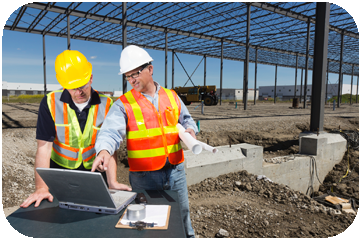Experienced Geotechnical Geologist for In-Depth Ground Investigations
Experienced Geotechnical Geologist for In-Depth Ground Investigations
Blog Article
How Consulting Engineers Enhance Geotechnical Engineering Projects: Insights Into Their Proficiency, Approaches, and Collaborative Approaches
Consulting designers are pivotal in boosting geotechnical design tasks, applying their specialized understanding to navigate the complexities of subsurface conditions. Their collaborative techniques foster communication amongst diverse project stakeholders, inevitably shaping the task's trajectory.
Function of Consulting Engineers
The expertise of consulting engineers in geotechnical design is fundamental to the effective implementation of building jobs. These specialists play a pivotal function in analyzing soil and rock residential or commercial properties, which are essential aspects influencing style and construction decisions. By conducting detailed site examinations, seeking advice from designers accumulate vital information that notifies the design process, making sure jobs are improved stable and ideal ground.
Consulting engineers also supply vital understandings right into threat management (geotechnical geologist). They identify prospective geotechnical threats, such as landslides, dirt liquefaction, and negotiation concerns, allowing stakeholders to execute reliable reduction approaches. Their competence aids in enhancing foundation styles, which can cause considerable expense financial savings and boosted safety and security
In addition, getting in touch with designers act as a crucial web link in between task owners, architects, and professionals. Their capability to translate complex geotechnical information right into actionable referrals promotes partnership and facilitates notified decision-making throughout the job lifecycle. This multidisciplinary method not only boosts job efficiency but additionally guarantees conformity with governing criteria and ideal practices.
Key Techniques in Geotechnical Engineering

One main methodology is site examination, which involves carrying out field tests and laboratory analyses to gather data on subsurface conditions. Methods such as Requirement Penetration Screening (SPT) and Cone Infiltration Screening (CPT) are extensively used to assess dirt stratigraphy and stamina. In addition, geophysical approaches, consisting of seismic and electric resistivity studies, give non-invasive methods to analyze subsurface characteristics.
Another vital method is mathematical modeling, which makes it possible for designers to imitate numerous circumstances and forecast exactly how soil-structure interactions will certainly act under different loading conditions. Finite Aspect Analysis (FEA) is a common technique employed in this context.
Furthermore, the layout of foundations, keeping structures, and earthworks counts greatly on these approaches - geotechnical geologist. By integrating sophisticated analytical tools with field information, consulting engineers can establish tailored options that deal with particular job challenges, ultimately adding to the stability and safety and security of construction tasks
Significance of Soil Evaluation
Dirt evaluation offers as a foundational aspect in geotechnical engineering, supplying important insights into the physical and chemical homes of dirt needed for effective building and construction preparation. Recognizing dirt qualities is critical for establishing its load-bearing capacity, water drainage habits, and possibility for settlement or instability. Comprehensive dirt examinations, consisting of sampling and research laboratory testing, aid identify specifications such as dirt type, wetness content, density, and shear stamina.
These analyses notify the option of appropriate construction techniques and products, eventually influencing project safety and security and longevity. For example, natural dirts might need various structure layouts contrasted to granular dirts, requiring customized this engineering services. In addition, soil analysis aids in determining contaminants that might pose risks to human health or the atmosphere, enabling the growth of mitigation techniques.
Integrating dirt evaluation into the onset of job growth assists to minimize unforeseen challenges, making sure that designers can expect and deal with potential issues before they intensify. By developing a thorough understanding of go to this site the site conditions, seeking advice from engineers can enhance layout efficiency and reduce prices, thus improving the overall success of geotechnical engineering tasks.
Collaborative Strategies in Projects
Successful geotechnical tasks often rest on joint approaches that bring together varied experience from different techniques. Efficient partnership amongst consulting engineers, rock hounds, ecological scientists, and building and construction professionals is essential for dealing with intricate obstacles and maximizing task results. By leveraging the one-of-a-kind skills and understanding of each staff member, jobs can gain from an all natural understanding of the site problems, governing needs, and engineering restraints.
Normal interaction and interdisciplinary conferences help with the sharing of understandings and cultivate a society of teamwork. These collective efforts allow the identification of prospective dangers early in the task lifecycle, enabling for prompt reduction strategies. Including feedback from stakeholders, consisting of regional communities and regulative companies, guarantees that all point of views are taken into consideration, boosting task acceptance and conformity.
Additionally, the assimilation of advanced modern technologies, such as Geographic Information Solution (GIS) and Building Info Modeling (BIM), additional improves collaboration. These tools permit for the real-time sharing of data and visualization of geotechnical conditions, advertising educated decision-making. Inevitably, a collaborative method not just enhances job implementation but also lays the structure for cutting-edge options to complicated geotechnical design challenges.
Effect on Task Outcomes

Consulting designers employ advanced techniques such as risk analysis and predictive modeling, which boost the precision of job forecasts. Their capability to incorporate innovative modern technologies, like geotechnical instrumentation and information analytics, additionally refines the style and construction processes. Therefore, projects experience enhanced performance, minimized costs, and reduced hold-ups.
Moreover, promoting effective interaction and collaboration among employee enhances analytical capacities. When obstacles arise, a joined front permits quick recognition of remedies, preventing potential obstacles. Ultimately, the collaborative efforts of consulting engineers add to better end results, ensuring that projects meet both regulatory requirements and client expectations.
Conclusion

Report this page